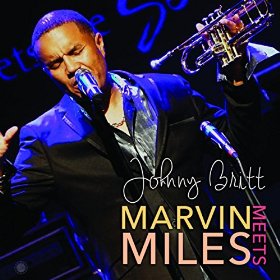Johnny Britt is a vocalist with range that lingers in that soft, buttery high tenor range regularly – though not exclusively – occupied by Marvin Gaye. Britt is also a trumpeter greatly influenced by the less is more ethos of Miles Davis. The fact that Britt sings and plays the trumpet explains why he would want to make the tribute album Marvin Meets Miles in which his Harmon muted trumpet provides the second “voice” to nine tunes from the Marvin Gaye songbook. Then there is also the Motown connection: Britt and partner rapper Sean E. Mac formed the group Impromp2 and once signed with the label that Gaye helped to make famous in the 60, 70s and 80s.
Johnny Britt is a vocalist with range that lingers in that soft, buttery high tenor range regularly – though not exclusively – occupied by Marvin Gaye. Britt is also a trumpeter greatly influenced by the less is more ethos of Miles Davis. The fact that Britt sings and plays the trumpet explains why he would want to make the tribute album Marvin Meets Miles in which his Harmon muted trumpet provides the second “voice” to nine tunes from the Marvin Gaye songbook. Then there is also the Motown connection: Britt and partner rapper Sean E. Mac formed the group Impromp2 and once signed with the label that Gaye helped to make famous in the 60, 70s and 80s.
One distinction between Britt and Davis is that Britt sings both on Impromp2 records and on his solo albums while Davis was content to let his horn do the talking. There is a history of singing trumpeters going back to Satchmo’s gravely baritone and includes the intimate stylings of Chet Baker – who along with Davis is also the subject of a biopic this year – and Chris Botti. However, it’s not correct to say that all Davis’ recordings were instrumentals. Kenny Hagood sang on the version of “Darn That Dream” heard on Birth of the Cool, but Davis was mainly an instrumentalist.
Later in his career Davis also expanded the jazz canon to include R&B numbers such as “Human Nature” and pop tunes like “Time After Time,” so the great innovator would understand the method to Britt’s madness on Marvin Meets Miles. Still, Marvin Meets Miles is a well thought out, high end R&B cover album rather than the type of jazz fusion records Miles made on In a Silent Way and beyond.
Miles and Britt do share a desire to attract top flight instrumental talent. For example, the bassist that gets the party jumpin’ here on “Got to Give It Up” is Marcus Miller, who played with Miles between 1980 and 1990. Britt also brought in tenor man Boney James, with whom he trades riffs on an instrumental version of “You Sure Love To Ball,” a record Britt and Mac included on their Impromp2 album It Is What It Is. Wah Wah Watson is understated yet distinct in the use of his trademark pedal on this version of “Let’s Get It On.” Watson knows this ground well because he played on the original recording in 1973. The guitar riff at the beginning is there, but Watson lays back and allows space for give and take with the other players, as well as Britt’s vocal.
The two best tracks on Marvin Meets Miles are “After The Dance” and “I Want You” because that’s where Britt comes closest to realizing his stated desire of replicating the human voice with his horn. Britt actually engages his horn in a musical conversation in an improvised introduction to “After The Dance.” He dispenses with the mute on “I Want You” and the depth of his instrument on this delightful version comes near to giving the tune the pathos and longing that Gaye brought to his original . For me, this is the standout track on Marvin Meets Miles
It is a credit to the writers, composers, singers, musicians, engineers, producers and Berry Gordy, that the songs in the Motown songbook hold up so well that they will sound good in the hands of anyone with talent and vision. While the quality of the music is never in question, many of these tunes have been done to death by vocalists and contemporary jazz instrumentalists. Britt could have easily done the basic smooth jazz instrumental tribute or he could have sung the songs to typical arrangements, and this would have been a pleasant if not wholly pleasing effort. And such an effort would have deprived listeners from wondering what would have happened if those two legends hooked up. Fortunately, Britt followed a different path and gave us an album with familiar elements but a new, enjoyable result. Recommended.
By Howard Dukes

